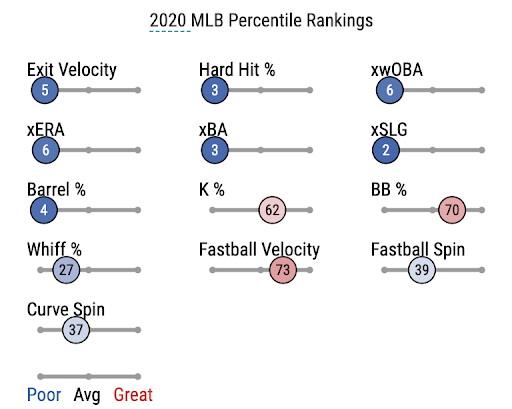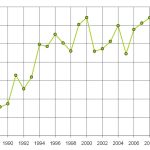The curveball and sinker are two different types of pitches in baseball. The curveball is a breaking pitch that has a downward and lateral movement, while the sinker is a pitch with heavy downward movement.
Both pitches are commonly used by pitchers to deceive hitters and induce ground balls. While the curveball is known for its spin and sharp break, the sinker relies on its sinking action to generate weak contact. Understanding the differences between these two pitches is crucial for both pitchers and hitters in order to be successful on the field.
This article will explore the characteristics and techniques associated with the curveball and sinker, providing insights into how they can be effectively utilized in a game.

Credit: theathletic.com
The Curveball
‘The Curveball’ is a pitching technique that has the ability to deceive batters through its sudden and unpredictable movement. It is a powerful weapon in a pitcher’s arsenal and is widely used in baseball. In this section, we will explore the definition and mechanics of a curveball, the advantages and disadvantages it offers, as well as some famous pitchers known for their exceptional curveball skills.
Definition And Mechanics Of A Curveball
A curveball is a type of pitch that breaks in an arcing trajectory, moving from the pitcher’s hand towards the batter in a downward and sideways motion. This movement is caused by the grip and hand position employed by the pitcher, along with the spin given to the ball by the fingers.
The mechanics of throwing a curveball involve several key elements:
- Grip: To throw a curveball, a pitcher typically holds the ball with their index and middle fingers placed along the horseshoe seams. This grip allows the pitcher to generate the necessary spin for the ball to break.
- Wrist Snap: As the pitcher releases the ball, they apply pressure on the outside of the ball with their middle finger. This action, combined with a downward snap of the wrist, imparts the necessary spin and creates the curveball’s movement.
- Arm Angle: The angle at which the pitcher releases the ball plays a crucial role in the curveball’s trajectory. By adjusting the arm angle, pitchers can manipulate the pitch’s break and location, making it challenging for batters to make solid contact.
Advantages And Disadvantages Of A Curveball
The curveball offers several advantages to pitchers:
- Deception: The sudden, curved movement of the ball can deceive batters, causing them to misjudge its location and timing. This can result in swings and misses or weak contact, giving the pitcher an advantage.
- Variation: By incorporating a curveball into their pitches, pitchers can introduce an element of surprise and variety in their repertoire. This keeps batters off-balance and makes it more challenging for them to anticipate the next pitch.
- Strikeout Potential: A well-executed curveball can be an effective tool for striking out batters. Its movement and change in speed can disrupt a batter’s timing and make it difficult to make solid contact with the ball.
However, the curveball also has some disadvantages:
- Control: Due to the complex mechanics involved, curveballs can be more challenging to control consistently. Pitchers may experience difficulty in consistently throwing accurate curveballs, leading to potential walks or hittable pitches.
- Injury Risk: The wrist snap required to generate the necessary spin can put added strain on a pitcher’s arm and increase the risk of injury. Overuse or improper form can lead to issues like tendonitis or ligament damage.
Famous Pitchers Known For Their Curveball
Throughout baseball history, several pitchers have gained fame for their exceptional curveball:
| Pitcher | Description |
|---|---|
| Sandy Koufax | Considered one of the best left-handed pitchers of all time, Koufax’s curveball had a sharp and devastating break. It was a key weapon in his dominant career, contributing to his numerous strikeouts and three Cy Young Awards. |
| Barry Zito | Zito’s curveball was known for its big vertical drop, baffling batters throughout his career. He won the Cy Young Award in 2002, in large part due to the effectiveness of his curveball. |
| Clayton Kershaw | Kershaw’s curveball is widely regarded as one of the best in the game. With its sharp break and tight spin, he has consistently racked up strikeouts and has been a dominant force for the Los Angeles Dodgers. |
In conclusion, the curveball is a fascinating pitch that adds complexity and excitement to the game of baseball. Its unique movement and deceptive qualities can give pitchers a significant advantage on the mound. While it has its advantages and disadvantages, the curveball remains an essential pitch in the arsenal of many notable pitchers throughout history.
/cdn.vox-cdn.com/uploads/chorus_image/image/72420129/1380924224.0.jpg)
Credit: www.blessyouboys.com
The Sinker
‘The Sinker’ is a popular and effective pitching technique utilized by many talented baseball players. This pitch is known for its downward movement and can be a game-changer in a pitcher’s repertoire. In this section, we will explore the definition and mechanics of a sinker, as well as the advantages and disadvantages it brings to the game. Plus, we’ll highlight some famous pitchers who have dominated the sport with their sinker.
Definition And Mechanics Of A Sinker
The sinker, also called a two-seam fastball, is a pitch that is primarily thrown by a pitcher who aims to induce ground balls from the batters. It gets its name from the way the pitch moves—instead of following a straight path, the sinker takes a downward trajectory, making it challenging for batters to hit with power.
To throw a sinker, the pitcher grips the ball with their index and middle fingers placed on the seams of the ball. This grip, often referred to as the two-seam grip, allows for better control of the pitch’s movement. As the pitcher delivers the ball, they put additional pressure on the inside part of the ball. This pressure, combined with the grip and the pitcher’s throwing motion, creates the characteristic downward sink of the pitch.
Advantages And Disadvantages Of A Sinker
The sinker offers several advantages for pitchers who can effectively master its mechanics. Let’s take a closer look at these advantages:
- Ground Ball Inducer: The primary objective of a sinker is to force batters to hit ground balls, leading to more outs and fewer home runs. Pitchers who utilize a sinker effectively can be extremely valuable to their team’s defense.
- Divergence from Hitters’ Expectations: Since a sinker moves in an unexpected downward motion, it can catch batters off guard, resulting in mistimed swings and less contact with the ball.
- Location Control: A well-thrown sinker allows the pitcher to control its location, aiming for the lower part of the strike zone where batters have difficulty making solid contact.
Despite its advantages, the sinker also has a few disadvantages for pitchers to consider:
- Less Velocity: Due to the pitcher’s grip and throwing mechanics required to achieve the sinker’s movement, it generally sacrifices some velocity compared to other pitches like a four-seam fastball.
- Pitcher Fatigue: The mechanics of throwing a sinker can put extra strain on a pitcher’s arm and lead to increased fatigue over time, potentially limiting its use during a game.
- Difficulty with Control: While location control is an advantage, it can be challenging to consistently throw an effective sinker. Achieving the perfect grip and pressure requires practice and skill.
Famous Pitchers Known For Their Sinker
Several renowned pitchers have made their mark in baseball history with their exceptional sinker. Here are a few notable examples:
| Pitcher Name | Notable Achievements |
|---|---|
| Curt Schilling | Three-time World Series champion |
| Derek Lowe | Two-time All-Star selection |
| Brandon Webb | Cy Young Award winner |
| Chad Bradford | Well-known for his unique submarine delivery |
These pitchers have showcased their mastery of the sinker, confounding batters and contributing to their teams’ success.
Comparing Curveball And Sinker
When it comes to pitching in baseball, two highly effective pitches often come to mind: the curveball and the sinker. Both pitches have their own unique characteristics and can be used effectively by pitchers. In this section, we will compare the differences in movement and speed, the effectiveness against different types of hitters, and the impact on pitching strategy and game plan between the curveball and the sinker.
Differences In Movement And Speed
The first major difference between the curveball and the sinker lies in their movement and speed. The curveball is known for its sharp downward break, causing it to drop dramatically as it approaches the plate. This vertical movement can be highly deceptive to hitters, making it a challenging pitch to hit. On the other hand, the sinker is characterized by its sinking action or downward movement. It has less vertical break compared to the curveball, but it moves horizontally as well, making it a versatile pitch for inducing ground balls.
Effectiveness Against Different Types Of Hitters
Each pitch has its own advantages when it comes to facing different types of hitters. The curveball, with its sharp downward break, is particularly effective against hitters who have difficulty hitting pitches low in the strike zone. Batters who are more prone to swinging over the top of the ball or popping it up are often troubled by the curveball’s movement. On the other hand, the sinker is highly effective against hitters who tend to hit the ball on the ground. Its sinking action makes it challenging for batters to lift the ball, leading to increased ground ball rates and potential double plays.
Impact On Pitching Strategy And Game Plan
The presence of the curveball or the sinker in a pitcher’s repertoire can greatly impact their overall strategy and game plan. When a pitcher possesses a devastating curveball, they may focus more on setting up hitters for breaking balls by establishing the fastball early in the count. This can throw off the timing and balance of the opposing hitters, leading to more swings and misses or weak contact. On the other hand, a pitcher with a reliable sinker may aim to induce ground balls and rely on their defense to make plays. This can be especially effective in situations where a double play is needed to get out of a scoring threat.
In conclusion, the curveball and the sinker offer different movement and speed characteristics, effectiveness against different types of hitters, and impact on pitching strategy. The choice between these two pitches depends on the pitcher’s strengths, the situation, and the weaknesses of the opposing hitters. Regardless of the choice, mastering either pitch can elevate a pitcher’s effectiveness and help them dominate on the mound.

Credit: www.tiktok.com
Training And Mastering The Pitches
Training and mastering the curveball and sinker pitches require a combination of skill, practice, and dedication. These pitches are known for their movement and deception, making them an excellent addition to any pitcher’s repertoire. In this section, we will explore the key aspects of developing the right grip and release for these pitches, as well as effective drills and exercises to improve them. Additionally, we will share some tips from professional pitchers who have successfully mastered these pitches.
Developing The Right Grip And Release
Getting the right grip and release is crucial when it comes to throwing a curveball and sinker effectively. Here are some tips to help you develop the right technique:
- Curveball: To throw a curveball, hold the ball with your index and middle fingers across the seams, creating a “C” shape. Keep your thumb underneath the ball for added control. As you release the pitch, snap your wrist downward, generating topspin that causes the ball to break downward and away from the hitter.
- Sinker: The grip for a sinker involves placing your two fingers (usually the index and middle fingers) alongside the ball’s seams. This grip allows you to apply pressure on the ball, causing it to move downward as it approaches the plate. Focus on keeping your arm angle consistent and releasing the ball with your fingers on top.
Drills And Exercises For Improving Curveball And Sinker
Regular practice and specific drills can help you improve the movement and control of your curveball and sinker. Here are some effective exercises to include in your training regimen:
- Curveball: One popular drill is the “Snap Drill.” Hold a towel or a short broomstick by its ends and simulate throwing a curveball motion, focusing on snapping your wrist at the release point. This drill strengthens the wrist and helps develop the proper mechanics for an effective curveball. Another useful exercise is the “Controlled Scramble.” Practice throwing curveballs with different amounts of break while targeting specific locations within the strike zone, mastering command and consistency.
- Sinker: A great drill to improve your sinker is the “Target Practice.” Set up different targets around the strike zone and focus on hitting those spots consistently with your sinker. This drill helps you develop control and accuracy with the pitch. Another effective exercise is the “Resistance Band Drill.” Attach a resistance band to a stationary object and simulate your pitching motion while feeling the resistance. This drill strengthens the muscles used in sinker delivery and enhances your ability to generate downward movement.
Tips From Professional Pitchers
Who better to learn from than the professionals who have successfully mastered these pitches? Here are some tips shared by experienced pitchers:
| Curveball | Sinker |
|---|---|
| • Focus on grip and wrist snap for maximum break. | • Keep your arm angle consistent to maintain sink and control. |
| • Vary the speed and break of your curveball to keep hitters off balance. | • Use your legs and lower body to generate power for a sinking action. |
| • Practice proper mechanics to avoid straining your arm. | • Trust the natural movement of the pitch and avoid overthinking. |
By following these tips shared by professionals, combined with consistent practice and dedication, you’ll be well on your way to mastering the curveball and sinker pitches.
Frequently Asked Questions For Curveball Vs. Sinker
What Is The Difference Between A Curveball And A Sinker?
A curveball is a breaking pitch that curves downwards due to spin, while a sinker is a pitch that moves downward but does not break. The main difference is in the movement and the way the pitcher grips the ball.
Are Curveballs And Sinkers Difficult To Hit?
Curveballs and sinkers can be challenging to hit because of their movement. Curveballs can break unpredictably, making it harder for the batter to anticipate where the ball will end up. Sinkers, on the other hand, drop quickly, often inducing ground balls and making it harder for the batter to make solid contact.
Which Pitch Is More Effective, A Curveball Or A Sinker?
The effectiveness of a pitch depends on the situation and the pitcher’s ability to execute it. Both the curveball and the sinker can be effective in different situations. A well-executed curveball can fool batters with its movement, while a well-placed sinker can induce ground balls and result in outs.
How Can Pitchers Develop A Good Curveball Or Sinker?
To develop a good curveball or sinker, pitchers need to practice proper grip and mechanics. For a curveball, mastering the grip and understanding the release point is crucial. Sinkers require a lower arm angle and generating downward movement. Consistent practice and coaching can help pitchers refine these pitches.
Conclusion
Ultimately, both the curveball and the sinker are effective pitches in their own right. While the curveball has a mesmerizing spin and a sudden drop, the sinker’s sinking action can deceive batters just as effectively. Each pitch requires skill and precision to execute, and choosing between them depends on the pitcher’s style and the game situation.
So, whether it’s the curveball or the sinker, mastering these pitches can make all the difference on the mound.

General Manager & Auditorial Head.
Killian Jake is a World Sports Traveler and hobbyist sports lover. By exploring different sorts of playing modules like indoor, outdoor, and many more. As for professionalism and writing, it’s helpful to give you the right suggestions on different games and sports.





